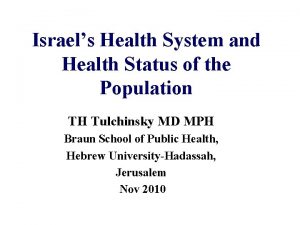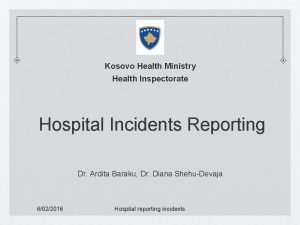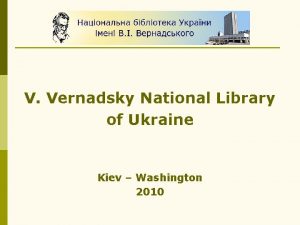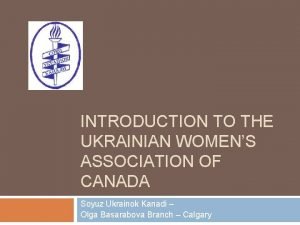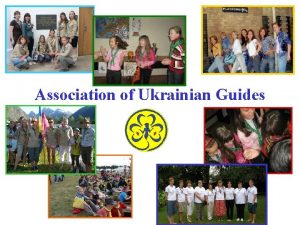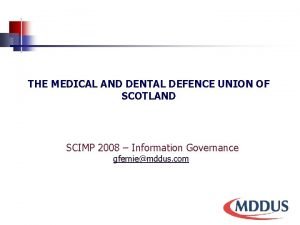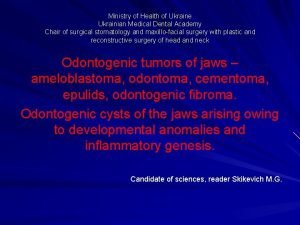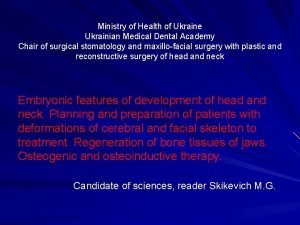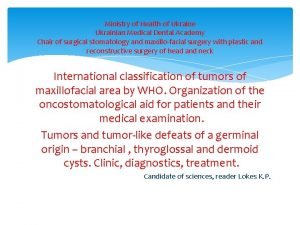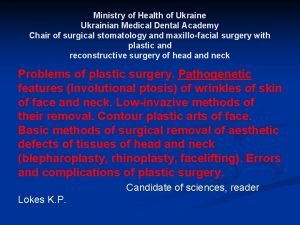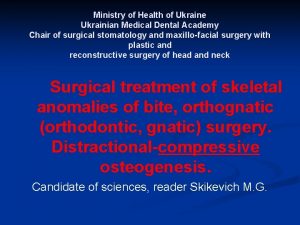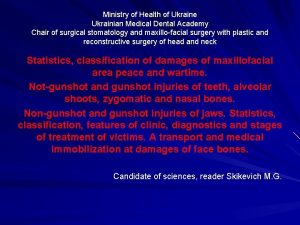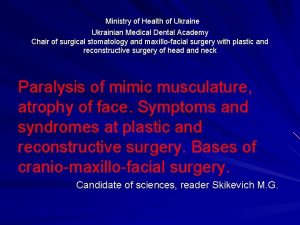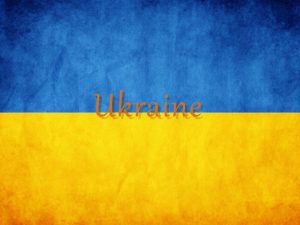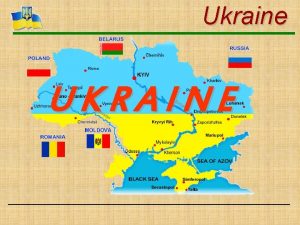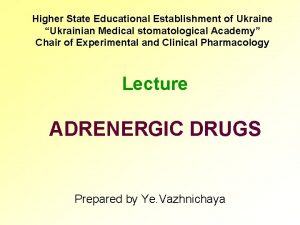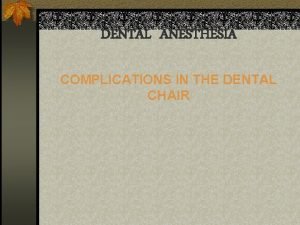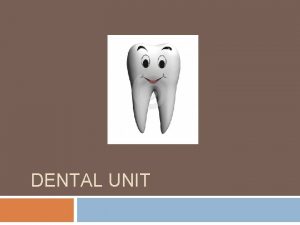Ministry of Health of Ukraine Ukrainian Medical Dental

































- Slides: 33

Ministry of Health of Ukraine Ukrainian Medical Dental Academy Chair of surgical stomatology and maxillo facial surgery with plastic and reconstructive surgery of head and neck Non gunshot and gunshot damages of soft tissues of face. Statistics, classification, features of clinic, diagnostics and treatment. Principles of surgical treatment of wounds. Stages of treatment of wounded with damages of soft tissues. Candidate of sciences, reader Lokes K. P

Lecture plan Non gunshot and gunshot damages of soft tissues of face. 2. Statistics, classification, features of clinic, diagnostics and treatment. 3. Principles of surgical treatment of wounds. 4. Stages of treatment of wounded with damages of soft tissues. 1.

Trauma is an influence on the organism of outward agent (mechanic, thermal, electric ray, psychical and oth. ), which provoked the anatomical and functional breaches in the organs and tissues, which are accompanied by local and general reaction of organism. n The dividing of traumas by character of damages is very important there are distinguished the open and closed traumas. There is a gaping of skin and mucous membranes wounds by the open damages. The microbes can penetrate through the wound of skin and mucous, that is promoted to developmental of early and later complications. There also distinguished the penetrating damages, in the presence of which the internal organs(of abdomen, of thorax, of skull, of joints and oth. ) can be affected, and unpenetrating. n

In case of damages of tissues of only one type we tell about the simple trauma, if the different tissues are damaged about complex trauma, for example, the skin, muscles and bone. n Trauma can be direct and undirect (damages developing in the distance from the region of provoking agent influence). The single and plurality traumas (politraumas) are possible. Ussually the traumas are acute. n

Symptomatics of patient with serious traumas is developed very quicly, state is often serious, often it is necessary for surgeon to orientate quickly, be able to specify the diagnosis and render first help. n At first, the outward look of damaged place not always corresponds to the seriousness of damage. n Secondary, not always the trauma, symptoms of which are obvious, is threating for human life, the diagnostic of plurality traumas is especially hard in patients, which are unconscious, in a state of serious shock or alcoholic intoxication. n Thirdly, the serious general phenomena (shock, acute anemia, traumatic toxicosis) can to conceal traumas. It is necessary to estimate then rightly and render the proper help. n

WOUNDS Definition n Wounds (vulnus) are the mechanical damage of the organism, which occur from destroying the integrity of the covered tissues skin or mucous membrane. During this damage there can be destroyed more deep tissues, inner organs (damage of the brain, liver, stomach, kidneys and others). The injury of the covered tissues separates the wound from other kinds of damage. For example the injury of the liver, which is caused by the dull trauma of the abdomen without destroying the skin, is the rupture and the damage during the stroke by a knife in the abdominal region wound of the liver, because we observe the destroying of the skin. n

The main features of the wounds are pain, bleeding and hiatus. Their devel opment depends on the localization of the wounds, mechanism of the damage, volume and deepness of the injury, and common condition of the patient.

Pain (dolor) It caused by direct damage of the nerves in the wounds region, and in result if it’s freezing during the development of the swelling. The pain can be localized not only in the place of damage but also it can be spread over the whole region of innervation. The intensivity of pain syndrome is deter mined: § Localization of the wound. § Injuries of the big nerves trunks are present. § The character of the weapon and the frequency of causing and wound the weapon is sharp and the damage of the receptor is less, and the pain is less. § Nerves psychological condition of the organism. § Pain is the protective reaction of the organism, but long and intense pain causes exhaustion of the central nervous system.

Bleeding (haemorrhagia) n Bleeding the constant feature of the wound because of the damage of the tissue starts from skin and mucous tissues and it is accompanied by the disturbance of the integrity of vessels. The intensity of the bleeding can be different from capillary to arterial bleeding.

n n n It is determined by: The presence of damage of big (or middle) vessels: arterial or vein ones. Localization of the wound. The most intensive bleeding is in injuring of the face, head, neck, manus the tissue of these parts of the body has more blood than others. The character of the weapon. The condition of local and common hemodynamics. When the arterial pressure is decreasing or squeezing of the magistral vessel the intensity of the bleeding decreases. The condition of the coagulation system.

Cleft (Hiatus) n The hiatus of the wound is caused by the contraction of the elastic fibers of the skin. Expressivities divergention of the skin’s borders of a wound first of all is deter mined by correlation of its axis to the Langergan’s lines. These lines shoe the main direction of the rough skin structures situation. For example, for decreasing of the hia tus during the operation of the extremities the surgeons choose the longitudinal direc tions of the incisions. The special means of direction of the incision is in cosmetic and plastic surgery during closed skin defects. For big hiatus of the wound (incisions of the festering) the incision is made perpendicularly to the Langergan’s line.

Classification according to the origin n All the wounds are divided into two groups: operative and accidental. n Operative wounds are caused deliberately, with treatment or diagnostic aim, in spe cial aseptic conditions, with minimal damage of the tissues, during the anesthesia, with hemostasis and by joining with stitches of the incisive anatomical structures. In such condition the pain is not present in case of the operative wounds, the possibility of the bleeding is minimal, and the hiatus of the wound is removed at the end of the operation by applying stitches, it means that the main wound features are removed arti ficially.

The operative wounds heal by the primary tension. n All other kinds of wounds are accidental. The common thing of the wounds is that they are caused contrary to the will. n

Classification according to character of tissue injure n n n n n cut or incised wound (vulnus incisum); stub or pierced wound (vulnus punctum); contused wound (vulnus contusum); lacerated wound (vulnus laceratum); crushed wound (vulnus conqvassatum); sabre or slash wound (vulnus caesum); bite wound (vulnus morsum); mixed wound (vulnus mixtum); gunshot wound (vulnus sclopetarium).

Cut wound (Vulnus incisum) A sharp object causes these wounds. During the influence of the tissues the effort is concentrated on the concrete area, and this area has the high pressure, and this influence divides the tissue in the direction of sharp objects action. The surrounding tissues dam age is not substantial. But the sharp object goes down to the internal organs and tissues. These wounds lead to a faint pain syndrome, big bleeding, and the hiatus depends on the correlation of the axis to the Langergon’s lines. Cut wound is dangerous with the ves sels damage; nervous damage if this trauma does not have such complications the wound is going to heal by primary tension.

n n STAB WOUND (Vulnus punctum) Колотая рана Stab wound is caused by narrow and pointed object. The anatomical peculiarities are large depth and small area of the injured skin and mucous tissue. The pain syndrome is slight, hiatus is absent, the external bleeding is absent, but hematoma can develop. Its special feature is damage of the inner vessels, nerves and organs. That’s why this kind of wound has the difficult diagnostics. During the stab wound the injure can be simple or with serious complications of the liver, stomach and others this condition can lead to death. This wound can lead to spreading of infection.

n n n According to the zone of damage: Wounds with a small zone of damage. These wounds have a small border of the incision and the necrotic zone is very small. The wounds with small zone have no complications, small hiatus. The wounds with a large zone of damage. These wounds have insignificant hemor rhage, strong pain, long healing, and many complications. Classification according to the level of infection Aseptic. Fresh infected. Suppurative.

n n n Gunshot wound This wound has three zones of damaging: wound canal. In some cases there can be a bullet, or parts of necrotic tissue, blood and bacterias. direct traumatic necrosis. Appears during the influence of kinetic energy. It consists of viable or unviable tissues, which are saturated with blood. the zone of molecular contusion. It consists of tissues, which have malfunction of metabolism and of cellular structures. During the uncomfortable conditions, for ex ample, the decreasing of perfusion, oxygenation, developing of the infection, the tis sues devitalize (die). This zone is called “a stockpile of the following necrosis”. This zone causes problems with treatment.

n n Complex anatomical character of damage High kinetic energy causes not only presence of three zones, but also their complex anatomical character. What does it mean? During the damage very often injure of some cavities of the organism is observed. Sometimes we can meet splinter fractures of the bones, and during injure of inner or gans we can observe their rupture. Not always the wound canal is the direct line from the entrance to the exit aperture. It may look as indmeet line and may cause the damage of different organs.

High level of infection n Gunshot wound is very often complicated by the development of infection. High level of infection with the necrotic mass increases the risk of suppuration. And accord ing to big damage of the muscle and small diameter of the entrance aperture, the access for the oxygen is very difficult, and this is the big evidence for the development of anaerobic infection.

n n n n According to the character of wound canal: A thorough damage it has entrance and exit apertures (a bullet is out of the organism). Blind injury in has only entrance aperture (bullet is at the end of wound canal). Tangential the damage of superficial tissues, without the penetration to the cavities of the organism. According to the factor of damage: Small speed damage gunshot. The speed of the bullet is 600 m/s. The wound canal more often may be direct and blind. Such wound has, as a rule, a small entrance aperture and not big tissue damage. High speed damage. The speed of the bullet is 900 m/s and more. These wounds have small entrance aperture and wide, with defect of tissues, exit aperture. Wound canal winding, that’s why we may observe the injury of many organs and tissues. More destroying effect may be caused by explosive shells. Shot wounds. These wounds have many separate apertures, bleeding, the contusion of organs and tissues.

bruises and laceration during treatment

after treatment

bitten wound

bitten wound

Cut wound

Cut wound

bitten wound

bitten wound

bruises and laceration

hematoma

Questions for discussion of the lecture 1. Anatomical and physiological features of soft tissues and facial bones. 2. Features of the clinic, diagnosis and treatment of non gunshot and gunshot wounds of the face. 3. The concept of secondary "shells" in surgery. 4. Features of the primary surgical treatment of a gunshot wound. 5. Features of the provision of step by step assistance to victims with injuries of soft tissues of the face.

Thank you for attention!
 Ukraine infrastructure ministry
Ukraine infrastructure ministry Amanda bleckmann ministry of health
Amanda bleckmann ministry of health Health ministry uk
Health ministry uk Israel ministry of health
Israel ministry of health Estonia health ministry
Estonia health ministry Diana shehu devaja
Diana shehu devaja Vernadsky national library of ukraine
Vernadsky national library of ukraine Ukrainian alphabet
Ukrainian alphabet History of pysanky ukrainian easter eggs
History of pysanky ukrainian easter eggs Christ our pascha
Christ our pascha Greatest ukrainian writers
Greatest ukrainian writers Ukrainian women's association of canada
Ukrainian women's association of canada Ukrainian proverbs with translation
Ukrainian proverbs with translation Ukrainian farmers
Ukrainian farmers Association of ukrainian guides
Association of ukrainian guides Ukrainian national credit union association
Ukrainian national credit union association Ukrainian state center for international education
Ukrainian state center for international education Traditional ukraine food
Traditional ukraine food Famous ukrainian americans
Famous ukrainian americans Scottish medical defence union
Scottish medical defence union Milestones of dental public health
Milestones of dental public health First dental home visit documentation form
First dental home visit documentation form Tools of dental public health
Tools of dental public health Borrego health urgent care cathedral city
Borrego health urgent care cathedral city Askov in public health dentistry
Askov in public health dentistry School health additional referral program
School health additional referral program Albany area primary health care dental
Albany area primary health care dental Dental health aide therapist
Dental health aide therapist Doctors license number
Doctors license number Gbmc medical records
Gbmc medical records Difference between medical report and medical certificate
Difference between medical report and medical certificate Torrance memorial medical records
Torrance memorial medical records Cartersville medical center medical records
Cartersville medical center medical records Language of ukraine
Language of ukraine



